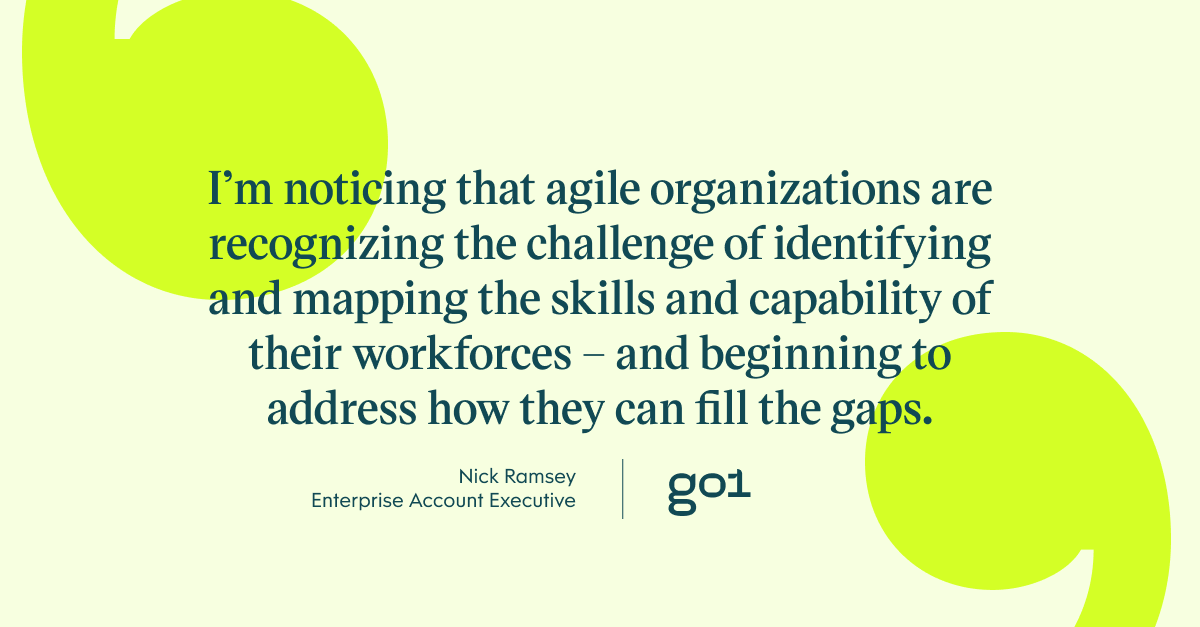
Stabilize your workforce with internal talent mobility

Partnering with Go1’s Enterprise Account Executive, Nick Ramsey, we investigate the current state of workplace stability, before diving into internal talent mobility and the interesting rise of talent marketplaces.
The current state of workforce stability
In a world where change is often the only constant, the idea of stability can feel like a faraway dream. One could assume there would be a limited case for ‘stability’ given the current state of the world’s workplace.
Can today’s employees really expect, or desire, stability after the last 5 years of digital transformation, pandemic disruptions, and rapid innovation?
Thankfully, the answer is a resounding yes. While the working world may be characteristically unstable, and could remain so for some time, there is a strong case for doubling down on efforts to stabilize your working environment. If for no other reason than to appeal as a breath of fresh air in the context of the otherwise chaotic 2020’s.
Don’t just take our word for it, the Reserve Bank of Australia recently reported that “workers' perceptions of their own job security have declined in recent years.” Similarly, the ADP finds that just 20% of workers feel their jobs are secure.
As such, employees are crying out for a greater sense of stability. According to a recent survey, 56% of people say that job stability is more important to them than flexibility. What’s more, 30% of people say that job stability is the number one reason they stay with their company (notably, even more important than salary for some), while 60% rate job stability among the top three most important reasons they remain at their job. On the other hand, employees who feel insecure about their job are 37% more likely to be disengaged.
Accordingly, a sense of stability at work is vital. Yet, it is safe to assume that most of your workforce are feeling the effects of the wider working world’s instability. If they are also experiencing any lack of clarity or ownership around their position and pathways at work, you can be sure that their engagement will take a knock.
Luckily, there’s a solution: talent mobility. Here’s everything you need to know about how internal talent mobility can help stabilize your workforce.

Investing into talent mobility
Skills development and career mobility are two of the most powerful ways an employer can increase their employees’ job security.
We spoke to Nick Ramsey, Go1’s Enterprise Account Executive, to gather his insights into where large organizations are (or should be) focusing their efforts to keep their best people in-house.
How valuable do you believe skills development is when future-proofing an organization?
It’s never been more important. The ever-growing skills gaps in key industries and areas has been widely publicised and we continue to see the impact of automation, accompanied by an increasingly volatile economic climate.
Skills development helps organizations future-proof their workforce – whilst offering employees much-desired opportunities for growth and development.
Where do you believe the balance should lie between autonomous (led by the employee) and structured (led by the employer) skills development?
I definitely believe the employer has the responsibility to make the right development opportunities available for their employees. The utopia is to build a learner-driven culture of curiosity as the pillar of a world-class learning culture. It’s definitely easier said than done. Learners need direct motivation and to understand the “why” of what’s in it for them.
Tools that can unlock this include targeted learning campaigns, marketing learning correctly and using data & insights to drive engagement. That’s why talent marketplaces have so much potential – they can identify the gap in the learner’s knowledge and present an opportunity to fill that gap with a relevant, personalised learning experience.

What is a talent marketplace?
A Talent Marketplace is essentially an internally leveraged platform which connects talent to opportunities. Employees promote their individual skills, career goals and preferences while gaining access to a broader selection of pathways than a traditional talent management program would provide. Josh Bersin describes them as a ‘Linkedin, but within the company’.
Have you noticed any increase or change in the conversations around Talent Marketplaces in the industry of late?
Absolutely. I'm noticing that agile organizations are recognizing the challenge of identifying and mapping the skills and capability of their workforces – and beginning to address how they can fill the gaps. It’s a task riddled with complexity but there is some amazing tech hitting the market that can have a huge amount of value when deployed correctly.
It’s still a space that’s growing – but one that will only continue to become more prevalent in the coming years.
Do you know examples of organizations successfully implementing a Talent Marketplace?
The early-adopters of talent marketplaces in Enterprise organizations are already starting to see the benefits. By their own admission, it is still early days, and they recognize that they are still in something of a pilot/MVP phase, particularly on identifying the right skills frameworks and technology to use.
Tools like Gloat and Eightfold.ai are being widely adopted, whilst we’re also seeing the conversation in more mid-market sized organizations, too. The positive here is that organizations are both identifying the gaps in their organization – and in turn the solutions required to address them.

What place does skills development have in talent mobility?
As always, L&D has a major role to play in this process to encourage talent mobility and stability. Attaching upskilling, reskilling and development opportunities is critical to a well-rounded talent mobility program. A robust development programme provides employees with the opportunity to gain new skills, thereby allowing them to explore new roles and opportunities outside of their current remit and take up other positions internally. In other words, L&D and internal mobility go hand in hand.
One sure-fire way to achieve this is by offering an integrated talent marketplace platform. Providing employees with a clear understanding of where they might need to upskill, as well as the learning pathways to gain these skills, will win their loyalty and engagement.
Josh Bersin also notes that promoting internal opportunities is one of the most powerful management practices in business. In fact, 94% of HR professionals say that internal recruiting helps retain their most valuable talent, while employees who move to a new role internally are 3.5x more likely to be engaged at work.
To learn more, check out our blog on why internal mobility is essential in today’s workforce.
For more insights, be sure to subscribe to the Go1 newsletter to stay on top of all the latest L&D trends. Or, you can book a demo today to find out how Go1 can help with your team’s learning needs.




